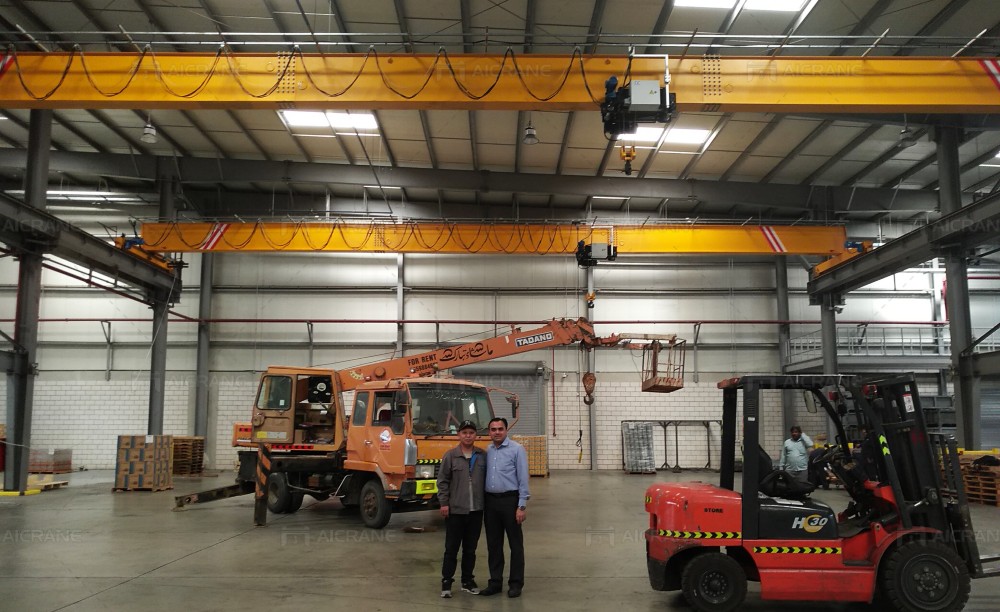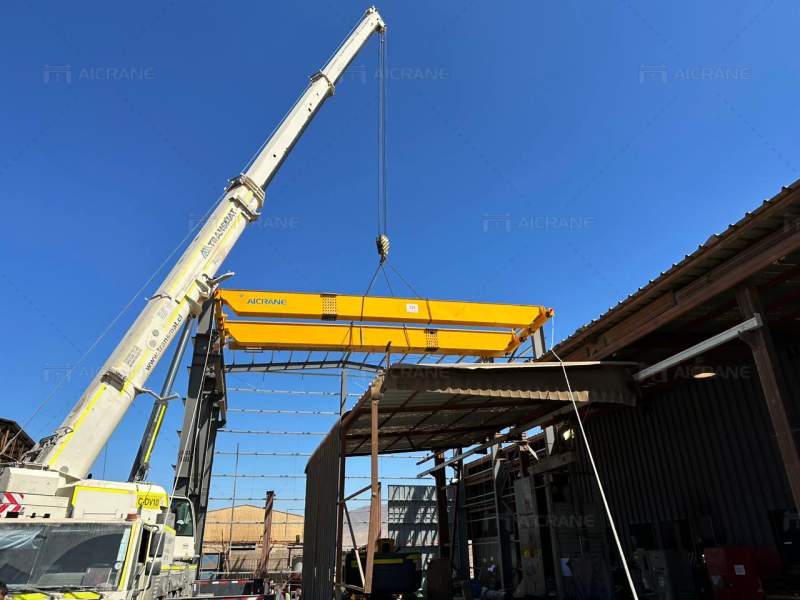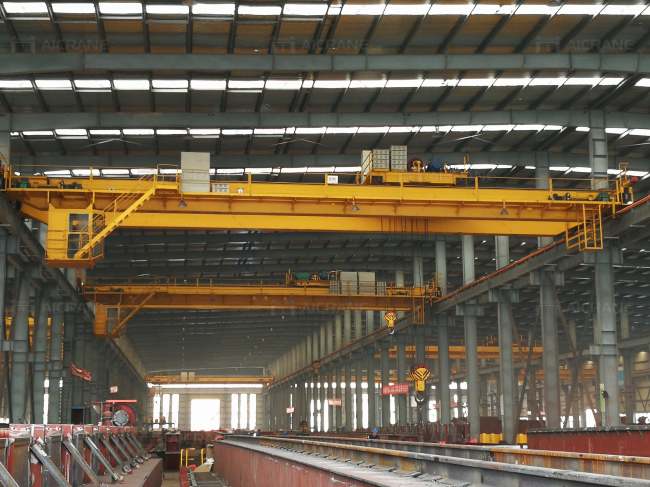44
0
0
Emerging Trends in Overhead Hoist Cranes for 2025 and Beyond
16
0
Overhead hoist cranes play a critical role in industries that require the efficient and safe handling of heavy loads. As we move into 2025, the overhead crane market is poised to undergo significant changes driven by advancements in technology, growing safety requirements, and environmental considerations. These trends are particularly evident in advanced systems like the double girder EOT crane , which is widely used in heavy-duty applications. This article explores the key trends shaping the future of overhead hoist cranes and how businesses can adapt to these developments.
1. The Integration of Smart Technologies
The adoption of smart technologies is revolutionizing the overhead crane industry. Internet of Things (IoT) devices, artificial intelligence (AI), and machine learning are being integrated into hoist cranes to enhance their performance and efficiency.

2. Enhanced Safety Features
Safety remains a top priority for industries using overhead hoist cranes. Manufacturers are focusing on innovative safety features to minimize risks and comply with stringent regulations.
3. Customization for Industry-Specific Needs
Different industries have unique requirements, and crane manufacturers are increasingly offering customized solutions to meet these needs. Double girder EOT cranes , for instance, are being tailored for specific applications such as shipbuilding, steel mills, and power plants.
4. Sustainability and Energy Efficiency
Sustainability is a growing concern across all industries, and the overhead crane sector is no exception. Manufacturers are focusing on reducing the carbon footprint of their equipment by incorporating energy-efficient technologies.
5. The Shift Toward Modular Construction
Modular construction techniques are gaining traction in the crane industry, offering numerous benefits:

6. Growth in Automation and Robotics
Automation and robotics are expected to dominate the overhead crane market in 2025 and beyond. These technologies offer improved efficiency, precision and cost savings.
7. Increased Demand for Heavy-Duty Applications
With the growth of infrastructure projects and industrial development, the demand for heavy-duty cranes like the double girder EOT crane is on the rise.
8. Digital Twins for Performance Optimization
Digital twin technology is emerging as a game-changer for overhead hoist cranes. By creating a virtual replica of the crane, operators can:
9. Regional Growth Trends
The demand for overhead hoist cranes is growing globally, with significant regional variations:

Conclusion
The overhead hoist crane industry is set to witness transformative changes in 2025 and beyond. From the integration of smart technologies and enhanced safety features to the rise of sustainability and heavy-duty applications, these trends are reshaping the market. The double girder EOT crane exemplifies how innovation can address the increasing demands for capacity, efficiency, and reliability. Businesses that embrace these emerging trends will be better positioned to optimize their operations and achieve long-term success.
1. The Integration of Smart Technologies
The adoption of smart technologies is revolutionizing the overhead crane industry. Internet of Things (IoT) devices, artificial intelligence (AI), and machine learning are being integrated into hoist cranes to enhance their performance and efficiency.
- Predictive Maintenance: IoT-enabled sensors collect real-time data on crane components, allowing for predictive maintenance. This reduces downtime and extends the lifespan of the equipment.
- Remote Monitoring and Control: Operators can now monitor and control double girder EOT cranes remotely, increasing safety and reducing the need for on-site personnel in hazardous environments.
- Automated Operations: Advanced AI algorithms enable cranes to perform complex lifting and positioning tasks automatically, improving precision and reducing the risk of errors.

2. Enhanced Safety Features
Safety remains a top priority for industries using overhead hoist cranes. Manufacturers are focusing on innovative safety features to minimize risks and comply with stringent regulations.
- Anti-Sway Technology: New cranes come equipped with anti-sway systems that stabilize loads during movement, ensuring safer operations.
- Advanced Load Monitoring: Enhanced load monitoring systems prevent overloading and ensure the safe handling of heavy materials, particularly with double girder EOT cranes , which are designed for high-capacity lifting.
- Emergency Stop Systems: Improved emergency braking systems enable quicker response times in critical situations, reducing the likelihood of accidents.
3. Customization for Industry-Specific Needs
Different industries have unique requirements, and crane manufacturers are increasingly offering customized solutions to meet these needs. Double girder EOT cranes , for instance, are being tailored for specific applications such as shipbuilding, steel mills, and power plants.
- Specialized Attachments: Custom grippers, magnets, and clamps are being developed to handle unique load types efficiently.
- Flexible Configurations: Cranes can now be designed with adjustable spans, lifting heights, and speeds to suit various operational environments.
- Compact Designs: For industries with space constraints, compact yet powerful overhead hoist cranes are becoming more popular.
4. Sustainability and Energy Efficiency
Sustainability is a growing concern across all industries, and the overhead crane sector is no exception. Manufacturers are focusing on reducing the carbon footprint of their equipment by incorporating energy-efficient technologies.
- Regenerative Braking Systems: These systems capture energy during braking and reuse it, reducing overall energy consumption.
- Eco-Friendly Materials: The use of recyclable and sustainable materials in crane construction is becoming more common.
- Energy Management Systems: Integrated energy management systems allow operators to monitor and optimize energy usage, making cranes more environmentally friendly.
5. The Shift Toward Modular Construction
Modular construction techniques are gaining traction in the crane industry, offering numerous benefits:
- Ease of Installation: Modular cranes are easier to assemble and disassemble, reducing installation time and costs.
- Scalability: Businesses can expand their crane systems by adding new modules as their needs grow.
- Maintenance Simplification: Modular designs simplify maintenance and part replacement, minimizing operational disruptions.

6. Growth in Automation and Robotics
Automation and robotics are expected to dominate the overhead crane market in 2025 and beyond. These technologies offer improved efficiency, precision and cost savings.
- Automated Guided Vehicles (AGVs): Cranes are being integrated with AGVs for seamless material handling in large warehouses and manufacturing plants.
- Collaborative Robotics: Robots working alongside cranes help streamline operations, particularly in industries requiring high precision, such as aerospace and automotive manufacturing.
7. Increased Demand for Heavy-Duty Applications
With the growth of infrastructure projects and industrial development, the demand for heavy-duty cranes like the double girder EOT crane is on the rise.
- Higher Lifting Capacities: New models are being designed to handle loads exceeding 500 tons.
- Longer Spans: Cranes with extended spans are being introduced to accommodate larger operational areas.
- Durable Materials: Advanced materials such as high-strength steel and composites are being used to enhance crane durability and performance.
8. Digital Twins for Performance Optimization
Digital twin technology is emerging as a game-changer for overhead hoist cranes. By creating a virtual replica of the crane, operators can:
- Simulate Operations: Test different scenarios to optimize performance without risking actual equipment.
- Monitor in Real-Time: Gain insights into the crane's condition and performance metrics.
- Improve Design: Use data from the digital twin to refine and improve future crane models.
9. Regional Growth Trends
The demand for overhead hoist cranes is growing globally, with significant regional variations:
- Asia-Pacific: Rapid industrialization and urbanization are driving the adoption of heavy duty cranes in this region.
- North America: Advanced manufacturing sectors and automation adoption are boosting the market for innovative crane solutions.
- Europe: Sustainability initiatives and strict safety regulations are influencing crane design and usage.

Conclusion
The overhead hoist crane industry is set to witness transformative changes in 2025 and beyond. From the integration of smart technologies and enhanced safety features to the rise of sustainability and heavy-duty applications, these trends are reshaping the market. The double girder EOT crane exemplifies how innovation can address the increasing demands for capacity, efficiency, and reliability. Businesses that embrace these emerging trends will be better positioned to optimize their operations and achieve long-term success.
Signatur